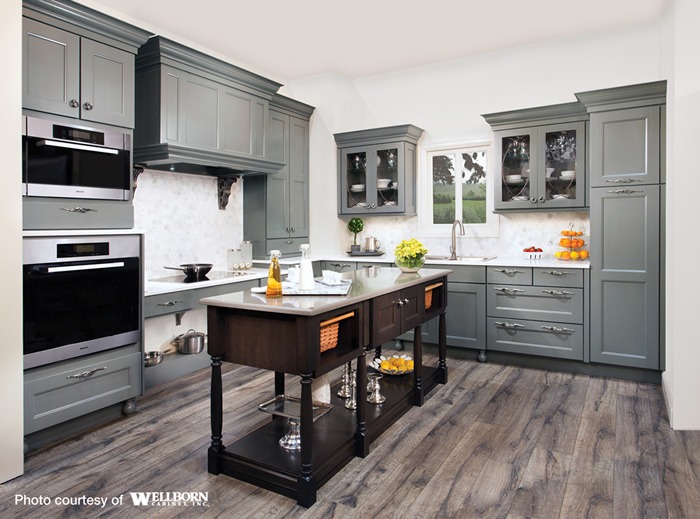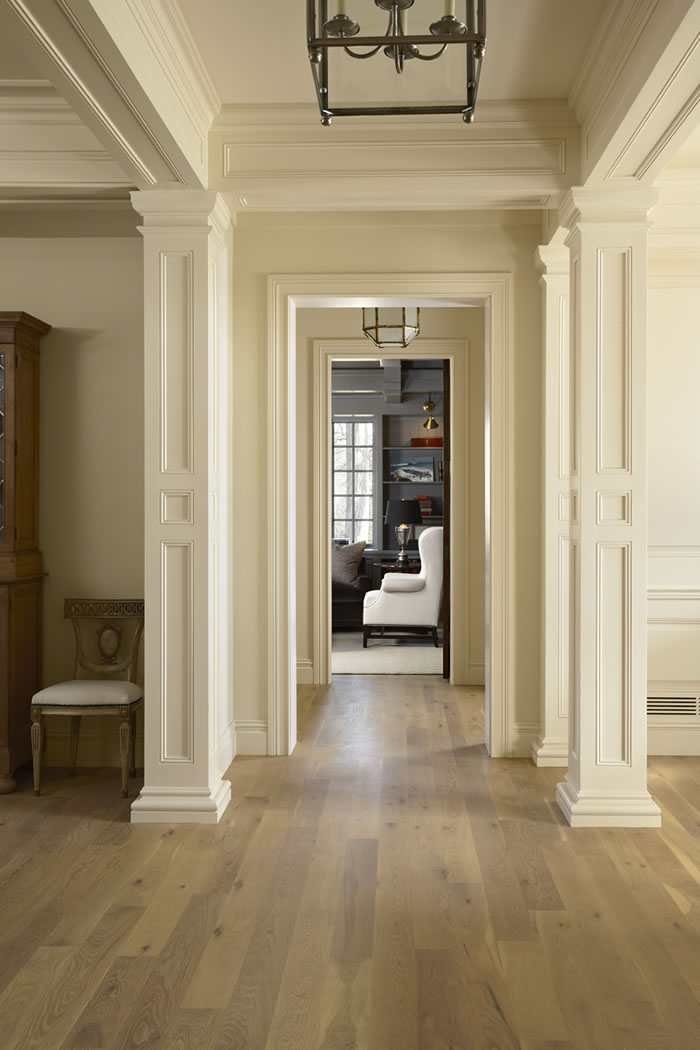5 Residential Design Trends in Hardwood
Hardwood may be one of the oldest building materials known to man, yet architects, designers, and homeowners are always finding fresh ways to use it in the modern home. What’s the appeal? Flexibility and variety, for starters.
“We’re constantly delighted to see how traditional woods like oak and walnut are being employed with renewed flair and imagination,” says Linda Jovanovich, of the American Hardwood Information Center. “Subtle tweaks can make something familiar, look innovative. The current trend is to take a classic hardwood application, like paneling or flooring, and give it a stylish, up-to-the-minute twist. Here’s a look at what’s trending.”

Maple cabinets by Wellborn are stained in a rich grey tone, complimented by a charcoal stained cherry island and contrasting hardwood floor.

Wide-plank walnut flooring by Carlisle Wide Plank Floors makes a lustrous statement in a traditional entry hall.
Wide-Plank Flooring
Perhaps no recent trend has been more influential than the use of wide-plank hardwood flooring. Traditional plank widths, ranging from 2¼ to 3 ½ inches, are still popular. But today’s homeowners often ask for widths between 5 and 7 inches, and there is even demand for up to 10 or 12 inches. “Wider floorboards can make a space look larger and more modern,” says Melissa Morgan of M Interiors in San Antonio, Texas, who has used the generously proportioned planks in traditional and contemporary homes. “With fewer seams, these floors can be treated like a canvas: ebonized oak or walnut for a sleek, dark look; light woods like ash or maple for a chic, urban vibe; weathered-gray tones for a slightly rustic affect—the possibilities are endless.”
Wood Ceilings
It used to be that hardwood planks primarily went on floors or walls, but today they’re appearing on residential ceilings too. “Simple poplar beadboard, painted white or with a light natural stain, looks crisp and airy overhead, adding visual interest while remaining quiet and unassuming,” says Rebecca Ascher, Ascher Davis Architects in New York and Newport, Rhode Island. “For a more assertive affect, I might specify tongue-and-groove walnut or hickory, characterful woods that provide a degree of drama. For that reason, they’re best reserved for large, high-ceilinged rooms that are not easily overwhelmed. In smaller, lower spaces, a ceiling with too much personality can feel oppressive.”
Mix and Match
Architects and designers, who once avoided using different varieties of hardwood in a single residential space, now mix and match them with newfound enthusiasm. Clearly contrasting wood tones—blond maple and black walnut, for example—create a striking effect that can work well in both traditional and contemporary settings. This is particularly true in kitchens, where a favorite configuration features upper cabinetry in a light-color wood such as birch, and lower cabinetry in a dark-color wood like cherry. The result is a space that has strong visual interest, and is light and airy, yet solidly grounded.
Gray Stains and Finishes
Gray is a classic “neutral” that never truly goes out of fashion. It’s currently one of the most popular colors, ranging from pale smoke to deep charcoal, showing up in hardwood flooring, paneling, and cabinetry. “Whether light or dark, gray stains bring out any wood’s natural grain and texture,” says New York interior designer Laura Bohn. “Grays are versatile and timeless—quiet and soothing colors that recede into the background without losing personality or becoming faceless. That’s why they work in any style décor, yet always look modern.”
Distressed Hardwoods
Homeowners drawn to the popular look of weather-beaten rustic and elegantly timeworn are turning to distressed hardwoods—new product to which scrapes, nail holes, notches, saw marks, and other signs of wear and tear have been carefully applied, often by hand. Manufacturers are able to reproduce convincing facsimiles of anything from the burnished walnut floorboards of an 18th century salon to the rugged oak-plank siding of a 19th century Pennsylvania barn. It’s a distinctive look that offers a wide range of aesthetics.



